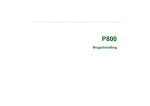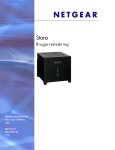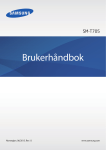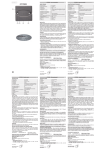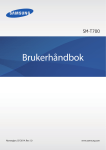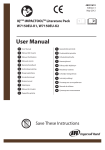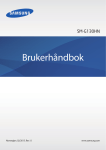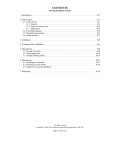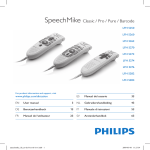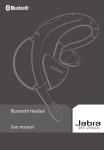Download SPECIFIC INSTRUCTIONS Swiveling Concrete Roof
Transcript
78 2105503 EN795: 1997 Class B SPECIFIC INSTRUCTIONS 48 Swiveling Concrete Roof Anchor NOTIFIED BODY: No. 0086 BSI Product Services Kitemark House Mayland Ave Hemel Hempstead HP2 4SQ UK Form No:5902401 Rev A 8 NOTIFIED BODY: No: 0321 SATRA Technology Centre Wyndham Way Telford Way Kettering Northants NN16 8 SD UK 9 © Copyright 2008, Capital Safety USA. 1 G B C A F E D 2 44.4 kN (10,000 lbs.) A B 22.2 kN (5,000 lbs.) 2 3 2.4 m 1.8 m 1.8 m 4 A B 3 5 C E D B A 6 7 D B A A C C B E 8 9 B A B A C 4 10 11 A 5 1 9 10 3 4 5 7 78 EN See ‘Glossary’ in “General Instructions for Use and Maintenance” for identification of numbered items in a white box. FR Voir Glossaire dans le mode d’emploi général (5902392) pour l’identification des articles numérotés dans les encadrés blancs. DE Siehe „Glossar“ in der Allgemeinen Anleitung (5902392), um nummerierte Teile in der weißen Schachtel zu identifizieren. IT Per l’identificazione degli elementi numerati in una casella bianca vedere il ‘Glossario’ nelle Istruzioni Generali (5902392). ES Para identificar las partes numeradas dentro de un cuadro blanco, consulte el apartado Glosario de las Instrucciones generales (5902392). PT Consulte o glossário nas “Instruções gerais” (5902392) para ver a identificação dos elementos numerados numa caixa branca. DA Se ”Glossar” under Generelle instruktioner (5902392) for identifikation af nummererede dele i en hvid kasse. NO Se Ordlisten i Generell instruksjon (5902392) for identifisering av nummererte deler i en hvit boks. FI Ks. Sanasto, osa Yleissohjeet (5902392), jossa on valkoisessa ruudussa olevien numeroitujen kohtien nimet. SV Se Ordlista under Allmänna instruktioner (5902392) för identifiering av numrerade föremål i en vit ruta. Label: RFID Tag FR I Étiquette sécurité DE i-Safe-Etikett IT I Etichetta di sicurezza ES Etiqueta I Safe PT Etiqueta I Safe DA I Sikkerhedsmærke NO I Sikkerhetsmerke FI I Safe -lipuke SV Etiqueta I Safe 6 labeling: iSafe™ Label 1 1. 1. 1. 1. 1. 1. 1. 1. 1. This product is i-Safe enabled and contains an electronic tag that can be read by compatible readers--providing inspection logs, inventory management and other safety information. Ce produit peut être activé i-Safe et il contient une étiquette électronique pouvant être lue par des lecteurs compatibles, à condition de fournir les historiques d’inspection, la gestion des inventaires et autres informations de sécurité. Dieses Produkt ist i-Safe-fähig und enthält ein elektronisches Etikett das von kompatiblen Lesegeräten ausgelesen werden kann und bietet so Inspektionsprotokolle, Bestandsmanagement und andere Sicherheitsinformationen. Questo prodotto è abilitato i-Safe e contiene un’etichetta elettronica facilmente leggibile da dispositivi di lettura compatibili al fine di fornire i verbali di collaudo, nonché istruzioni di gestione dell’inventario e altri dati di sicurezza. Este producto cuenta con la cobertura i-Safe y contiene una etiqueta electrónica que puede ser leída por lectores compatibles, que facilita los historiales de inspección, el control de inventario, así como otra información relativa a la seguridad. O produto contém a funcionalidade i-Safe bem como uma etiqueta electrónica que pode ser lida por leitores compatíveis – apresentando historial de inspecções, gestão do inventário e outras informações de segurança. Dette produkt er i-Safe aktiveret og indeholder en elektronisk etiket, som kan aflæses af kompatible aflæsere--den giver inspektions logbøger, lagerstyrelse og anden sikkerhedsinformation. Dette produktet er i-Safe-aktivert og innholder en elektronisk tagg som kan leses ved hjelp av kompatible leseenheter - som gir inspeksjonslogger, lagerstyring og annen sikkerhetsinformasjon. Tämä tuote on varustettu i-Safe-toiminnolla Label: RFID Tag FR Étiquetage : étiquette i-Safe™ DE Etiketten: iSafe™-Etikett IT Etichettatura: Etichetta i-Safe™ ES Etiquetado: Etiqueta iSafe™ PT Etiquetagem: etiqueta iSafe™ DA Mærkning: i-Safe™ mærkat NO Merking: i-Safe™-merke FI Merkinnät: i-Safe™-tarra SW Etikett: i-Safe™-etikett 1. ja se sisältää elektronisen lipukkeen, joka on luettavissa yhteensopivilla lukulaitteilla. Tämä mahdollistaa tarkastuslokit, varastonhallinnan ja turvallisuustietojen tarkistuksen. Denna produkt är i-Safe-aktiverad och innehåller en elektroniskt märkning som kan avläsas av kompatibla avläsare--som tillhandahåller inspektionsloggböcker, inventariehantering och annan säkerhetsinformation. FR Étiquette : étiquette RFID DE Etikett: RFID-Tag IT Etichetta: Tag RFID ES Etiqueta: Etiqueta RFID PT Etiquetagem: etiqueta RFID DA Mærkat: RFID-mærkat NO Merke: RFID-etikett FI Merkintä: RFID-tarra SV Etikett: RFID-märke 7 GB SPECIFIC instructions - Swiveling Concrete Roof Anchor. 1.0 Description/Purpose The Capital Safety Swiveling Concrete Roof Anchor includes (see Figure 1) tripod base (1A), swivel head (1B), ratchet buckle (1C), and web assembly (1D) including the web strap (1E),web guide (1F) and roller (1G). The swivel head is designed for installation of a Capital Safety Ultra-Lok® model self retracting lifeline (SRL). The tripod base allows installation to a precast concrete anchorage, such as a lifting eye. The anchor may be used as part of a personal fall arrest system (PFAS). Do not hang, lift or support tools or equipment from these roof anchors or attach guy lines for antennas, phone lines, etc. warning: See General Instructions for Use and Maintenance section 1.1 and 1.3, 1.4 and 1.12. IMPORTANT: If you have questions on the use, care, or suitability for use of this equipment, contact Capital Safety. This instruction manual is intended to be used in conjunction with the instruction manuals supplied with each system component mentioned below, if applicable. If an instruction was not supplied with the purchase of that component, contact Capital Safety immediately. 2.0 requirements The following application limitations must be recognized and considered before using this product: • CAPACITY: The roof anchor is designed for use by one person with a personal fall arrest system (PFAS). • PERSONAL FALL ARREST SYSTEM: The swiveling roof anchor is designed to be used in conjunction with the Capital Safety Ultra-Lok® SRL model 3504500, but may also be used with models 3504430 and 3504450. Other PFAS’s used with this roof anchor must meet CE requirements. PFAS’s incorporating a full body harness must be capable of arresting a worker’s fall with a maximum arresting force of no greater than 6kN (1351 lbs.) (EN363) and limit the free fall distance to 4 m (13 ft.) or less. • STRUCTURE: This anchorage connector is intended to be installed on concrete structures. The anchorage to which the roof anchor is installed must meet minimum strength(s) as given below for the applications selected: • Fall Arrest: The loads applied to the roof anchor from personal fall arrest systems are magnified by the design of the roof anchor. See Figure 2. The Concrete Swiveling Roof Anchor requires anchorages that are able to support 44.4kN (10,000 lbs.) in a vertical direction (2A) and 22.2kN (5,000 lbs.) 8 horizontally (2B) for fall arrest applications. • Restraint: The loads applied to the roof anchor from personal fall arrest systems are magnified by the design of the roof anchor. The Concrete Swiveling Roof Anchor requires anchorages that are able to support 2722 kg (6,000 lbs.) for restraint applications in a vertical (2A) position and 1361 kg. (3000 lbs.) in a horizontal position. See Figure 2. Anchorages used for attachment of personal fall arrest systems (PFAS) shall be independent of any anchorage being used to support or suspend platforms. Consult Capital Safety before using this swiveling anchor on any other applications. • LOCKING SPEED OF SRL: Situations which do not allow for an unobstructed fall path should be avoided. Working in very confined or cramped spaces may not allow the body to reach sufficient speed to cause the SRL to lock should a fall occur. Working on slowly shifting material such as loose shingles may not allow enough speed build-up to cause the SRL to lock. A similar situation may occur on low pitched roofs where a worker may slide instead of fall. A clear path is needed to assure positive locking of the SRL. • ENVIRONMENTAL HAZARDS: Use of this equipment where environmental hazards exist may require additional precautions to reduce the possibility of injury to the user or damage to the equipment. Hazards may include, but are not limited to: • Corrosion: Use near sea water or other corrosive environments may require more frequent inspections or servicing (replacement) to assure corrosion damage is not affecting the performance of the product. • Chemicals: Solutions containing acids, alkali, or other caustic chemicals, especially at elevated temperatures may cause damage to this equipment. Consult Capital Safety if doubts exists concerning installing this equipment where chemical hazards are present. • Electrical: Do not install the roof anchor where it or the user may come into contact with electrical power lines. • COMPATIBILITY OF COMPONENTS: This equipment is designed for use with Capital Safety approved components and subsystems only. See also General Instructions for Use and Maintenance Section 1.12. • COMPATIBILITY OF CONNECTORS: Connectors (hooks, carabiners, D-rings) must be capable of supporting at least 22 kN (5000 lbs.). Connectors must be compatible with the anchorage and other system components and meet EN362 standards. See also 9 General Instructions for Use and Maintenance Section 5. 3.0 Training It is the responsibility of the users of this equipment to understand these instructions, and to be trained in the correct installation, use, and maintenance of this equipment. These individuals must be aware of the operating characteristics, application limits and consequences of improper installation or use of this equipment. This user manual is not a substitute for a training program. Training must be provided on a periodic basis to ensure proficiency of the users. See also General Instructions for Use and Maintenance 1.1. 4.0 planning Before each use of this equipment, carefully inspect it according to section 7.0 of this manual. Do not use if inspection reveals an unsafe condition. Plan your fall arrest system before starting your work. Take into consideration factors affecting your safety at any time during use. The following list gives some important points you must consider when planning your system: • ANCHORAGE: Select an anchorage point that is rigid and capable of supporting the required loads. See section 2.0 “Anchorage Strength.” • Site Plan: Before starting the roof construction, plan where the roof anchor(s) will be installed and when, during the construction process, they may be used. The following are guide lines on locating roof anchors (see Figure 3): • The roof anchor is for use in an upright position on a horizontal surface only. • The roof anchor should be located at least 1.8 m (6 ft.) away from any leading edge. On very small roof areas, locate the roof anchor as far from the leading edge as possible. • Do not leave the roof anchor permanently installed. The roof anchor is designed for temporary use only. • TOTAL FALL DISTANCE: Should a fall occur, there must be sufficient clearance in the fall area to arrest the fall before striking the ground or other object. The total fall distance is the distance measured from the onset of a fall to the point where the fall is arrested. A number of factors can influence the total fall distance including; user’s weight, anchorage location relative to the fall (swing fall), body support with sliding D-ring, and the type of fall arrest equipment you attach to the roof anchor. For specific clearance requirements read and follow the manufacturer’s instructions for your subsystem fall arrest equipment. • SWING FALLS: See Figure 4. Swing falls occur when the anchor10 age point is not directly above the point where a fall occurs. The force of striking an object while swinging (horizontal speed of the user due to the pendulum affect) can be great and may cause serious injury. Swing falls can be minimized by working as directly below the anchorage point as possible. In a swing fall situation, the total vertical fall distance of the user will be greater than if the user had fallen vertically directly below the anchorage point. The user must therefore account for an increase in the total free fall distance and the area needed to safely arrest the fall. See also General Instructions for Use and Maintenance Section 1.10. The SRL will activate (lock-up) regardless of it’s orientation and location relative to the user’s position. Do not captivate the lifeline of an SRL, it may affect the performance of its braking. If a swing fall hazard exists in your application, contact Capital Safety before proceeding. • SHARP EDGES: Avoid working where the connecting subsystem (i.e. SRL, full body harness, lanyard, lifeline, etc.) or other system components will be in contact with, or abrade against unprotected sharp edges. See Figure 5. If working with the roof anchor (5A) near sharp edges (5B) is unavoidable, protection against cutting must be provided by using a heavy pad or other means over the exposed sharp edge. If you are not using the Leading Edge SRL (PN 3504500), it is recommended that an EN 355 compliant energy absorber (5C) (PN 1220362) be installed in-line between the harness (5D) and the self retracting lifeline (5E) to further protect the worker. Compatibility and total fall distance issues must be considered if this is done. Contact Capital Safety before using inline energy absorbing components or lanyards with self retracting lifelines. • RESCUE: See General Instructions for Use and Maintenance section 1.6. • AFTER A FALL: See General Instructions for Use and Maintenance section 1.2. • OTHER CONSIDERATIONS: Avoid working where your line may cross or tangle with that of another worker or another object. Do not allow the lifeline to pass under arms or between legs. Never clamp, knot or otherwise prevent the lifeline from retracting or being taut, avoid slack line. Do not lengthen the SRL by connecting a lanyard or similar component without consulting Capital Safety. 5.0 INSTALLATION • Roof anchor installation: Roof anchors must be installed in accordance with the Section 4 “Site Plan.” Site work rules must be followed regarding when an installed roof anchor is ready for use (i.e. properly braced, etc.). Step 1: Position the roof anchor over an anchorage capable of withstanding the loads (see Section 2 “Anchorage Strength”). 11 Step 2: Ensure the shackle (6A) attached to the ratchet buckle is positioned over the lug (6B), and the pin (6C) is in place. See Figure 6. Step 3: In Figure 1, the ratchet strap (1E) must pass through the black plastic web guide (1F) built into the roof anchor (1A) and over the roller (1G) as the strap exits the top member of the tripod. In Figure 7, the strap must also pass through the center of the ratchet buckle hub (7A). To release the ratchet strap (7B), pull the lever (7C) on the ratchet handle and move the ratchet buckle handle to the “full up” position (7D). Step 4: Pull out as much of the strap as necessary to connect the hook to the anchorage (8A). Ensure the latch on the hook fully closes over the anchorage (8B). Do not use on anchorages that load only the tip of the hook or side load the hook. Do not use on anchorages that prevent the hook latch from closing. The tripod must straddle the anchor, i.e., the anchor must be inside the tripod legs. See Figure 8. The diameter of the anchorage cross section (8C) must be less than 25.4 mm (1 in.). ADJUSTMENT: See Figure 7 to remove slack in the ratchet strap. Pull the lever on the ratchet handle and rotate the handle downward (7E). With the handle in the open position (7D), release the lever (7C) and continue to rotate the handle down. The ratchet mechanism will allow the handle to take up more slack with each upward rotation. Continue the ratchet movement until the strap is taut. Lock the ratchet strap by returning the ratchet buckle handle to the full down position before use (7E). Ensure the ratchet buckle remains in the full down working position during use. • INSTALLING THE SRL: In Figure 9, the SRL mounts to the swiveling roof anchor with two 9.5 mm (3/8 in.) bolts (9A) and nylon insert nuts (9B). See SRL manufacturer’s instructions for use. REMOVAL: The roof anchor is a temporary anchor. To remove it, pull the lever on the ratchet handle (7C) and rotate the handle to the full up position (7D). See Figure 7. When the lever is released it will snap into a locked position (7E). The center hub (7A) will then rotate freely and the ratchet strap (7B) may be pulled out to create enough slack for the hook to be removed from the anchor. • BODY SUPPORT: When using the Swiveling Concrete Roof Anchor, it is recommended that a full body harness be worn. For general fall protection use, connect to the D-ring on the back between the shoulders (dorsal D-ring). 12 warning: Body belts are not allowed for free fall situations. Body belts increase the risk of injury during fall arrest in comparison to a full body harness. Limited suspension time and the potential for improperly wearing a body belt may result in added danger to the user’s health. See also General Instructions for Use and Maintenance section 2.0 • CONNECTING TO THE Roof anchor: Figure 10 illustrates the proper connection of typical fall arrest equipment to the roof anchor. Always protect the lifeline from abrading against sharp or abrasive surfaces on the roof. Make sure all the connections are compatible in size, shape and strength. Never connect more than one personal protective system to any single roof anchor at a time. • CONNECTING THE SRL: Connection to the installed roof anchor is made by attaching the self locking snap hook at the end of the Ultra-Lok’s® lifeline to the back dorsal D-ring of the user’s full body harness. When connecting, make sure the connecting hook is fully closed and locked. Review section 4.0 if using an SRL near sharp edges. 6.0 USE Once attached to the roof anchor, the worker is free to move about within the recommended working areas. • SRL: Should a fall occur, a speed sensing brake system will activate, stopping the fall and absorbing much of the energy created. Sudden or quick movements should be avoided during the normal work operation since this may cause the SRL to lock-up. NOTE: This series of SRL’s incorporates a brake system with a cam rocker brake engagement that creates an audible indicator (clicking sound) which informs the user that the brake pawl system is working properly. For further information on the Ultra-Lok® SRL, refer to the manufacturer’s instruction manual. 7.0 Inspection Before each use, visually inspect the roof anchor per the steps listed below. important: See General Instructions for Use and Maintenance 1.2 regarding equipment that sustains a fall. Record inspection results in the Periodic Examination and Repair History Log at the end of this instruction, or use the i-Safe™ inspection web portal to maintain your inspection records. See Figure 5. If you are a first-time user, contact Capital Safety, 1-800-328-6146 or if you have already registered, go to: www.capitalsafety.com/isafe.html. Follow the instructions provided with your i-Safe handheld reader or on 13 the web portal to transfer your data to your web log. warning: Extreme working conditions (harsh environment, prolonged use, etc.) may require increased frequency of inspections. • INSPECTION POINTS: (Refer to manufacturer’s instruction supplied with each system component for inspection procedures) • Inspect the roof anchor for physical damage. Look carefully for any signs of cracks, dents or deformities in the metal. • Inspect the roof anchor for signs of excessive corrosion. Make certain the anchor swivels 360° properly and if applicable that the Ultra-Lok® SRL is attached to the anchor correctly. • Inspect each system component or subsystem (i.e. SRL, full body harness, lanyard, lifeline, etc.) per associated manufacturer’s instructions. • Inspect the webbing material. It must be free of frayed, cut, or broken fibers. Check for tears, abrasions, mold, burns, or discoloration, etc. The webbing must be free of knots, excessive soiling, heavy paint buildup, and rust staining. Check for chemical or heat damage indicated by brown, discolored, or brittle areas. Check for ultraviolet damage indicated by discoloration and the presence of splinters or slivers on the webbing surface. All of the above factors are known to reduce webbing strength. Damaged or questionable webbing should be replaced. Inspect stitching for pulled or cut stitches. • Inspect the web guide for deformation or cracks. The web guide prevents the web from abrading against the steel tubing. • Inspect the hook for distortion, sharp edges, burrs, cracks, worn parts or corrosion. Ensure the hook works properly. The hook gate must move freely and lock upon closing. 8.0 Product life As long as the Concrete Swiveling Roof Anchor passes inspection by a competent person1, it may remain in service. See General Instructions for Use and Maintenance Section 1.16 for warranty information. 9.0 maintenance/storage/Transport • Maintenance: Clean the swivelling tripod anchor with a mild soap detergent solution. Excessive build-up of dirt, tar, etc. may prevent the anchor from working properly. A small amount of oil or grease can be applied to the anchor to help the swiveling action. If you have any questions concerning the condition of your roof anchor, or have any doubt about putting it into service, contact Capi- 1 Competent Person: An individual who is knowledgeable of a manufacturer’s recommendations, instructions, and manufactured component who is capable of identifying existing and predictable hazards in proper selection, use, and maintenance of fall protection 14 tal Safety immediately. Refer to the manufacturer’s instructions supplied with each system component for maintenance, servicing, and storage procedures. • Storage: See General Instructions for Use and Maintenance Section 3.3. • transport: See General Instructions for Use and Maintenance Section 3.4. 10. Servicing Additional maintenance and servicing procedures (i.e. replacement parts) must be completed by a factory authorized service center. important: Only Capital Safety or parties authorized in writing may make repairs to this equipment. 11.0 SPECIFICATIONS component material Tripod Base Carbon Steel Swivel Head Carbon Steel Webbing Polyester Rachet Web Hook Forged Steel FINISH: Black E-coat paint and zinc-plating WEIGHT: 15 kg (33 lbs.) (without SRL) SIZE: 66 cm x 66 cm x 61 cm (26 in. x 26 in. x 24 in.) CAPACITY: One person MINIMUM BREAKING STRENGTH: 22.2 kN (5,000 lbs.) 12.0 LABELING Labels should be securely attached to the tripod anchor and fully legible. See labels. 15















